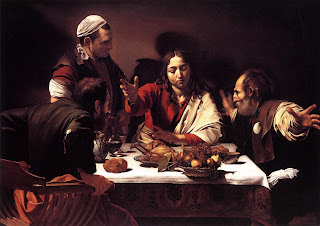Supper at Emmaus

(A unpublished review for New City)
Caravaggio’s “Supper at Emmaus” and other “Caravaggesque” paintings, at the Art Institute of Chicago, through Jan. 31
1600 was a big year for Michelangelo Merisi da Caravaggio (1571-1610), and for the history of European painting, as that young man became famous for a dramatic realism that would develop a style for the counter-Reformation and begin to visualize the world of the street instead of the palace. One year later, he painted the “Supper at Emmaus” which is currently hanging in Gallery 211 at the Art Institute, surrounded by the works of those who followed him in the 17th. Century. And it has to be seen to be believed. Not so much for its fine detail, as for its size, and the way the figures project themselves into the viewer’s space, as it realizes that moment when God, through the Holy Ghost, dramatically entered human history. Which is to say, this is a very effective liturgical painting, and makes almost everything else in the room feel merely picturesque, especially the otherwise excellent painting by his rival, follower, chronicler, and bitter enemy, Giovanni Baglione (1566-1643).
 Here's the Baglione
Here's the BaglioneSt. Francis

And here's a version
that Caravaggio did
about 5 years earlier
Why is it so effective? Certainly the drawing is important. Caravaggio drew directly on the canvas, unlike so many others who could only make great drawings on paper (Il Guercino, for example, whose “Entombment” hangs on the opposite wall).
 Guercino
GuercinoAnd here, in the actual painting, you can feel the careful modulation of tonal values that escaped so many of his followers (especially Bartolomeo Manfredi and Cecco del Caravaggio, whose works now hang on the same wall),
 Manfredi
Manfredi Ceccio
Ceccioand escape all of the reproductions. (especially those transparencies that visited L.U.M.A. a few years ago) But overall, you just have to credit this tormented young man’s prophetic vision, which seems to have needed the power and beauty of divine grace much more than the rest of us.























